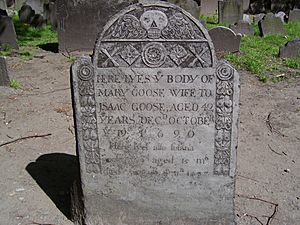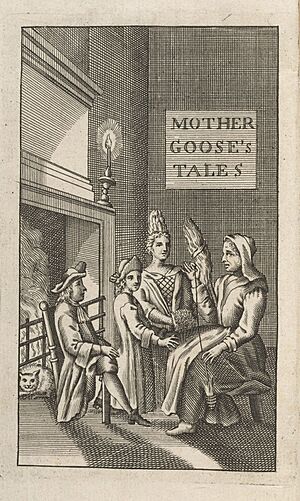Mother Goose facts for kids
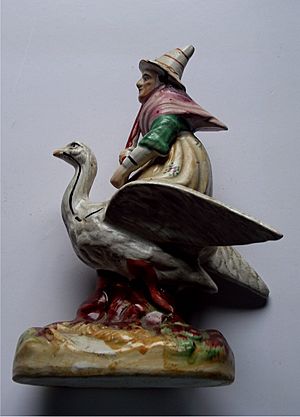
Mother Goose is a famous name linked to many nursery rhymes and fairy tales. People often think of her as the author of these classic stories and songs. Some believe the real "Mother Goose" lived in New England or France centuries ago. However, the name became popular in England when a book of poems called Mother Goose's Melody was published in 1781. Since then, "Mother Goose" has been the well-known name for children's poetry.
Contents
Who is Mother Goose?
Mother Goose is a made-up character, often seen as an old country woman. She is given credit for many popular stories and rhymes that became famous in the 1600s. But no one specific writer has ever been found with that name.
In the 1600s, English readers knew characters like "Mother Hubbard." French writers also mentioned "Mother Goose" (or "Mère l'Oye") in their works, showing the name was already understood.
Some people, like Katherine Elwes-Thomas, think the idea of "Mother Goose" might come from old legends about a French queen named "Bertha the Spinner." She was said to tell amazing stories that children loved.
There's a popular story in Boston, Massachusetts, that the first Mother Goose was a woman named Elizabeth Foster Goose or Mary Goose. This story says she lived in Boston in the 1660s. She was supposedly the second wife of Isaac Goose. The story goes that she sang many songs and rhymes to her grandchildren. Other children would gather to listen. Her son-in-law, a publisher, supposedly collected her rhymes and printed them. However, there is no proof that these prints ever existed.
Most experts, like Iona and Peter Opie, do not believe these stories. They agree that "Mother Goose" is just a name for a collection of stories and rhymes, not a real person.
Perrault's Fairy Tales
Charles Perrault was a French writer who helped start the idea of literary fairy tales. In 1695, he published a collection of fairy tales. It was called Stories or Tales of Past Times, with Morals, but it became better known as Tales of My Mother Goose. This book is the first clear starting point for the "Mother Goose" stories we know today.
In 1729, an English version of Perrault's book came out. It was called Histories or Tales of Past Times, Told by Mother Goose. This book introduced famous fairy tales like Sleeping Beauty, Little Red Riding Hood, Puss in Boots, and Cinderella to people who spoke English.
The Mother Goose stories first appeared in America in Worcester, Massachusetts. A printer named Isaiah Thomas reprinted the English version in 1786.
Mother Goose and Nursery Rhymes
The name "Mother Goose" became strongly linked to English nursery rhymes in the late 1700s. A book called Mother Goose's Melody, or, Sonnets for the Cradle was likely published around 1780 or 1781 by Thomas Carnan. This book helped make "Mother Goose" the well-known name for children's poetry in the English-speaking world.
In music, Maurice Ravel wrote a piano suite called Ma mère l'oye (My Mother Goose), which he later turned into a ballet. There is also a song called "Mother Goose" by the progressive rock band Jethro Tull from their 1971 album Aqualung.
"Old Mother Goose" Poem
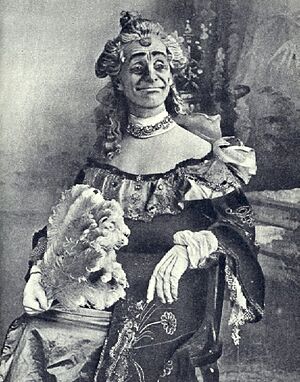
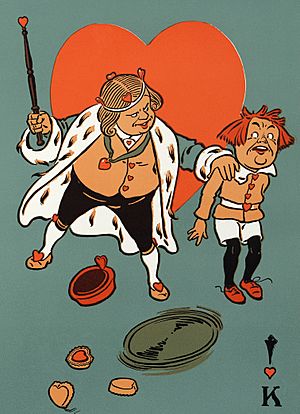
Mother Goose is not just the supposed author of rhymes; she is also a character in one of them:
Old Mother Goose,
When she wanted to wander,
Would ride through the air
On a very fine gander.
Jack rode to his mother,
The news for to tell;
She called him a good boy
And said it was well.
Then Jack went a-courting
A lady so gay,
As fair as the lily,
And sweet as the May.
But then the old Squire
Came behind his back,
And began to belabour
The sides of poor Jack.
Then old Mother Goose,
That instant came in,
And turned her son Jack
Into famed Harlequin.
So then with her wand,
Touched the lady so fine,
And turned her at once
Into Sweet Columbine.
The old egg in the sea
Was thrown away then--
When Jack jumped in,
And got it back again.
Jack's mother came by,
And caught the goose soon,
And mounting its back,
Flew up to the moon.
Other Books and Adaptations
Many books and other works have featured Mother Goose or her stories. Here are a few examples:
- Mother Goose in Prose by L. Frank Baum (1897), who also wrote The Wonderful Wizard of Oz.
- The Space Child's Mother Goose by Frederick Winsor (1958), which gives the rhymes a space theme.
- The Inner City Mother Goose by Eve Merriam (1969), a modern take on the rhymes.
- The Random House Book of Mother Goose by Arnold Lobel (1986), which includes over 300 nursery rhymes.
- My Very First Mother Goose by Iona Opie (1996), a collection of 68 rhymes.
- Monster Goose by Judy Sierra (2001), which features monster characters.
- Mother Osprey: Nursery Rhymes for Buoys & Gulls by Lucy A. Nolan (2009), with a sea theme.
Mother Goose stories have also been adapted into puppet shows, musicals, and even murals, like the one by Elba Lightfoot at Harlem Hospital in New York.
Related pages
Images for kids
-
Joseph Grimaldi (right) in the "favourite pantomime of Mother Goose".
See also
 In Spanish: Mamá Oca para niños
In Spanish: Mamá Oca para niños


